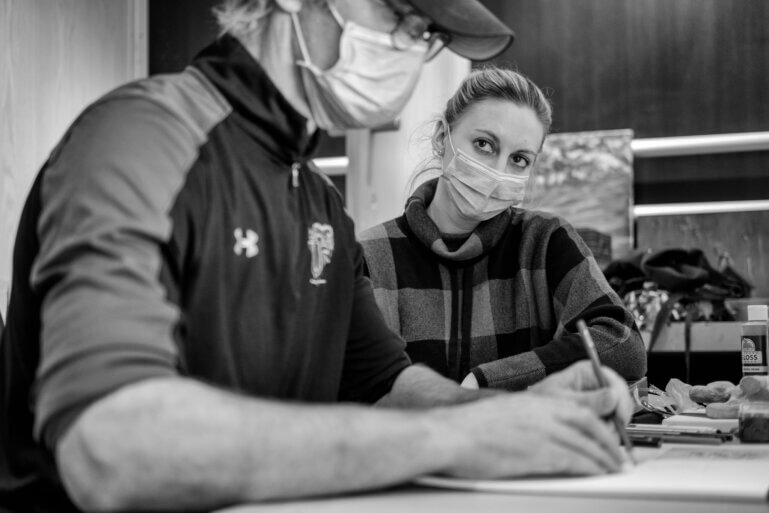Communication and cognition—two words that affect how we interact with our world. We communicate with our coworkers, family, and friends, by speaking to them, texting them, emailing them, and through so many other communicative modalities. Cognition is heavily intertwined with communication and is the defining characteristic of how we perceive interactions and the actions we take day-in and day-out. We are constantly faced with situations that require our faculties including problem-solving, judgment, memory and other areas of executive function. Our level of cognition is crucial to the results of our actions.
Consider how these routine scenarios and communications might be affected when one’s cognitive function, communicative abilities, or physical capabilities are hindered by a brain injury, stroke, or spinal cord injury.
At QLI, the Speech and Life Skills team is dedicated to assisting clients in regaining their communicative and cognitive function and agency through either rehabilitation practices or compensatory strategies—Director of Clinical Services Taylor Kerschke leads the team, consisting of licensed speech-language pathologists, speech and life skills assistants, and vocational specialists.
Communication
Should an incoming client exhibit communicative difficulties, assessments are completed to determine the nature and degree of resulting deficits. This is the foundation of the client’s rehabilitation plan at QLI. “These formal assessments target many areas,” says Kerschke, “including expressive and receptive
Aphasia can leave someone without the ability to form longer sentences, say a word they meant to, or substitute a made-up word (neologism) instead of a real one. A sampling of what these aphasia-focused sessions may include are word association activities (matching a word to an image with a few given options), slow, enunciated speech practice (a speech therapist or assistant typically don a clear mask for the activity, stressing each syllable and demonstrating for the client the ways the mouth moves for each), or reading comprehension activities.
Vocation and Cognition
Assessments are also administered to determine how cognition may affect vocational capabilities following an injury. General memory and organization within daily life are the focal points of the formal vocational assessments the Speech and Life Skills team conducts.
“In addition to memory and organization,” says Kerschke, “our formal assessments gauge our clients’ responsibility of and ability to navigate key areas like their finances and benefits, and their overall awareness of safety and community access.”
A defining characteristic of this department is the drive to get out of “four-walled” rooms. Real-world application and simulation of key activities are paramount to rebuilding neural pathways and—ultimately—an individual’s success in rehabilitation. With this aim to get out into the community is the functional assessment side of Speech and Life Skills.
“These assessments typically take place off-campus,” says Kerschke. “A team member will accompany a client, usually heading into a store with clear tasks in mind for the client to accomplish.” For example, the assessment might take place in the Target near campus. A speech and life skills team member will prepare a shopping list with a particular focus, like office supplies. The assessment will then focus on the client’s ability to correctly find the items on the list, and pay for them. With this assessment, the team members will assess the strengths and areas of deficits exhibited, and from that point put a more pointed plan in place.
Collaboration with other departments is significant in how a client’s program can be managed. This 
Physical therapy sessions with the client focus on treadmill and NuStep exercise, building leg strength and stamina. Occupational therapy sessions focus on the aspects of feeding oneself, noting any potential deficit with coordination, such as cutting food with a utensil. Rounding out the collaboration, speech therapy sessions tailor phrase practice on ordering food while the life skills team navigates any cognitive barriers that may arise, such as being able to safely cross the street, or pay for the meal. Kerschke notes that the ultimate goal with many clients is to help them have more independence with their activities, making collaboration with other departments the advantageous route.
The vocational team will help to assess a client’s ability to get back to work in some form following their discharge. Three factors that must align for such a program to be pursued:
- Is the client physically or cognitively able to return to the job they held prior to injury? If not, are there alternative employment or volunteer options?
- The employers’ ability to accommodate the discharged client.
- The client’s own willingness to return to work.
Some professions that utilize specific equipment or are more physically demanding many require additional assessments, such as a tools assessment for a construction job. Should a client prove to be on a positive path towards returning to work, Whitver will tailor sessions to work with the client on the demands of their role.
Speech and life skills is, in many respects, the “arm” of rehabilitation programs. It applies the guiding rhythms of many programs, to make sure of what can be accomplished after discharge and any deficits that remain. Getting clients back to independence and life necessitates these types of programs. Through their implemented success, clients not only build cognitive and vocational strengths, but are primed to be better communicators. In a further sense of these programs being “arm,” the successes built during them act as a bridge, connecting one’s progress during rehabilitation to their undeniable progress in a post-discharge environment.
Categories: Brain Health, Speech and Life Skills
